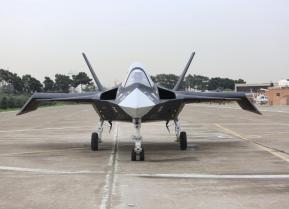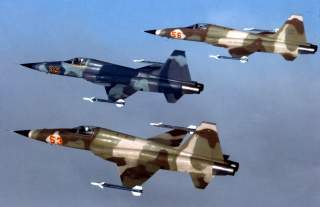Is Iran's 'New' Jet Fighter or a Total Hoax?
Or is just a copy of this picture?
The latest episode with the not-Kowsar fighter illustrates yet again the casual dishonesty of Tehran’s propagandists. Iranian industry wanted to display the Kowsar-88 for an expo—which does appear to be a real airplane! However, the actual Kowsar-88 wasn’t ready for display this August, so Tehran simply took an old, very well-known jet fighter and claimed it was a new one, in full view of domestic and international audiences that would know better.
In February 2017 I published an article on the Iranian Saeqeh (“Thunderbolt”) fighter. Billed as Iran’s first domestically-built jet fighter to enter operational service, the Saeqeh.
(This first appeared several months ago.)
Fast forward a year and a half later and we are again greeted with headlines for yet another “100% indigenously made” fighter jet, this time a “state of the art” two-seater called the Kowsar. And yet it appears identical to an F-5F Tiger II two-seater jet.
If anything, it is far less original than the Saeqeh, which has airframe modifications including enlarged strakes and twin vertical tail stabilizers. The Kowsar doesn’t appear to have any external changes from the F-5F. How was this jet even worthy of the photo-op with Iranian President Hassan Rouhani in the instructor’s seat for Iranian Defense Industry Day?
It happens there really is a program to build a combat-capable Kowsar advanced jet trainer. It simply wasn’t the aircraft on display this summer.
According to Iranian aviation expert Babak Taghvaee, the Kowsar may merely be an avionics testbed—a regular F-5F fitted with new avionics (rumored to be of Chinese origin) eventually intended for use in the Saeqeh fighter, spruced up with a fresh coat of gleaming paint for the photo-op. The test-bed used may date all the way back to Iran's first attempt to reverse-engineer the F-5 in the 1990s, the Azaraksh. This was because the real Kowsar-88 wasn't ready yet.
Iran had announced back in 2013 it was developing a Kowsar-88 trainer which could also serve in the light attack role. In 2017, footage of a prototype undergoing taxi trials was unveiled which you can see here.
Though influenced by the F-5, the prototype is a different airplane and is much shorter. Interestingly, it bears a striking resemblance to the Taiwanese AIDC AT-3 jet trainer. Details are scarce, but the actual Kowsar-88 apparently would have a digital glass cockpit using three multi-function displays and uses two J85-13 turbojet engines reverse-engineered from the F-5.
The public has had short memories as President Rouhani also attended a ceremony showing off the Kowsar-88’s in July 2017. Even the most uninformed observer can compare this Kowsar to the one displayed August 2018 and see they are not the same airplanes.
According to the European Defense Review, sixteen domestically-built Kowsar-88s are planned to take over training duties currently undertaken by the more capable Saeqeh jets in the next decade. Iran will attempt to acquire additional J85 engines on the black market, but if that fails, will cannibalize the parts from twelve older F-5A and B model aircraft.
Meanwhile, Tehran reportedly plans to deploy fifty single-seat Saeqeh-1 fighters and fourteen two-seat Saeqeh-2 fighters by rebuilding additional rusty old F-5E and F-5F airframes. Depending on the status of international sanctions, Iran may also seek to procure Russian Yak-130 or Chinese JL-10 (aka L-15 Falcon) supersonic trainers.
Recommended: Imagine a U.S. Air Force That Never Built the B-52 Bomber
Recommended: Russia's Next Big Military Sale - To Mexico?
Recommended: Would China Really Invade Taiwan?
Versatile trainer/light attack jets continue to be popular with militaries across the globe from China’s L-15, to the Nigerian Alpha Jets fighting Boko Haram, to South Korea’s FA-50 Golden Eagle, which has seen a lot of combat in The Philippines. In addition to being forgiving stepping stones for training fighter pilots to fly more demanding aircraft, advanced jet trainers can perform counter-insurgency and strike missions far more cost-efficiently than a high-performance jet fighter. Supersonic trainers with radar can also perform light air defense duties.
Of course, these are not the sort of aircraft one uses to fight off F-15 Eagles or F-22 stealth fighters, which is precisely the major threat Iranian defense have to worry about coming from the United States, Israel and Saudi Arabia.
Instead, programs like the Kowsar reflect Tehran’s plans to shore up fighter pilot training and sustain the number of operational airframes capitalizing on the raw material furnished by America prior to the Iranian Revolution if international sanctions curtail foreign procurement—as seems more likely since U.S. withdrawal from the nuclear deal.
The latest episode with the not-Kowsar fighter illustrates yet again the casual dishonesty of Tehran’s propagandists. Iranian industry wanted to display the Kowsar-88 for an expo—which does appear to be a real airplane! However, the actual Kowsar-88 wasn’t ready for display this August, so Tehran simply took an old, very well-known jet fighter and claimed it was a new one, in full view of domestic and international audiences that would know better.
The irony is that Tehran doesn’t need to be ashamed of its resourceful use of old jet fighters. In the nine-year-long Iran-Iraq war during the 1980s, Iranian fighter pilots fought one of the most intense air wars in recent history defending their home soil. Though higher-performance F-4 Phantoms and F-14 Tomcats shot down dozens of Iraqi fighters (and suffered losses in return), even the F-5s chalked up a number of kills against MiG-21 fighters and Su-20 attack jets.
Sébastien Roblin holds a Master’s Degree in Conflict Resolution from Georgetown University and served as a university instructor for the Peace Corps in China. He has also worked in education, editing, and refugee resettlement in France and the United States. He currently writes on security and military history for War Is Boring.


